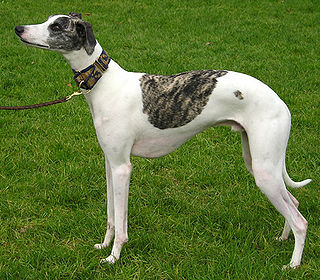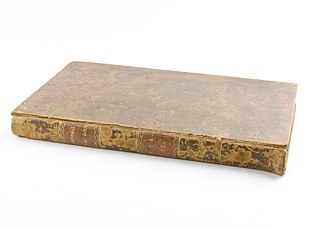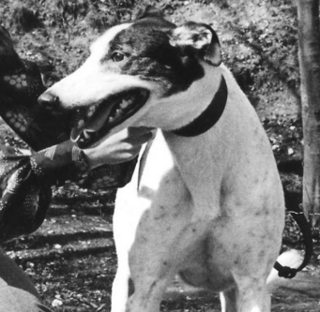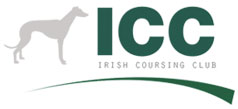
The EnglishGreyhound, or simply the Greyhound, is a breed of dog, a sighthound which has been bred for coursing, greyhound racing and hunting. Since the rise in large-scale adoption of retired racing Greyhounds, the breed has seen a resurgence in popularity as a family pet.

The Italian Greyhound or Italian Sighthound is an Italian breed of small sighthound. It was bred to hunt hare and rabbit, but is kept mostly as a companion dog.

Sighthounds are a type of hound dog that hunts primarily by sight and speed, unlike scent hounds, which rely on scent and endurance.

The Galgo Español, or Spanish Greyhound, is an ancient breed of dog, specifically a member of the sighthound family. The English greyhound is possibly a descendant of the Spanish greyhound and, for several years in the 20th century, some breeders did cross-breed Galgos and Greyhounds in order to produce faster and more powerful Galgos, specifically for track racing purposes.

Greyhound racing is an organized, competitive sport in which greyhounds are raced around an oval track. The sport originates from coursing. Track racing uses an artificial lure that travels ahead of the greyhounds on a rail until the greyhounds cross the finish line. As with horse racing, greyhound races often allow the public to bet on the outcome.
Lure coursing is a sport for dogs that involves chasing a mechanically operated lure. Competition is typically limited to dogs of purebred sighthound breeds. The AKC has a pass/fail trial for all breeds called the Coursing Ability Test (CAT) and a timed 100 yard dash called Fast CAT where the dog's speed is converted to points.

Coursing by humans is the pursuit of game or other animals by dogs—chiefly greyhounds and other sighthounds—catching their prey by speed, running by sight, but not by scent. Coursing was a common hunting technique, practised by the nobility, the landed and wealthy, as well as by commoners with sighthounds and lurchers. In its oldest recorded form in the Western world, as described by Arrian—it was a sport practised by all levels of society, and it remained the case until Carolingian period forest law appropriated hunting grounds, or commons, for the king, the nobility, and other landowners. It then became a formalised competition, specifically on hare in Britain, practised under rules, the Laws of the Leash'.

A lurcher is a crossbred dog resulting from mating a greyhound or other sighthound with a dog of another type such as a herding dog or a terrier. The lurcher is not a "breed," but is a generic descriptor of a group of varying dogs. It was for hundreds of years strongly associated with poaching; in modern times, it is kept as a hunting dog or companion dog.

The Waterloo Cup was a hare coursing event organised by the National Coursing Club. The three-day event was run annually at Great Altcar in Lancashire, England, from 1836 to 2005 and it used to attract tens of thousands of spectators to watch and gamble on the coursing matches. It was founded by a Liverpool hotelier on land owned by William Molyneux, 2nd Earl of Sefton, who was patron of the event until his death in 1838.

Hare coursing is the pursuit of hares with greyhounds and other sighthounds, which chase the hare by sight, not by scent.

The Magyar agár (MA) is a dog breed. It is a type of sighthound originating in Hungary and lands that previously belonged to the Austro-Hungarian Empire. It is used for hunting and coursing, and is also kept as a companion.

Greyhound racing is a sport in the United Kingdom. The industry uses a parimutuel betting tote system with on-course and off-course betting available. Attendances have declined in recent years, primarily due to the decrease in evening fixtures with the majority of fixtures being held in the daytime due to betting shop demands.

The Thoroughbred is a horse breed developed for horse racing. Although the word thoroughbred is sometimes used to refer to any breed of purebred horse, it technically refers only to the Thoroughbred breed. Thoroughbreds are considered "hot-blooded" horses that are known for their agility, speed, and spirit.

The Jersey Act was a regulation introduced to prevent the registration of most American-bred Thoroughbred horses in the British General Stud Book. It had its roots in the desire of British horse breeders to halt the influx of American-bred racehorses of possibly impure bloodlines during the early 20th century. Many American-bred horses were exported to Europe to race and retire to a breeding career after a number of U.S. states banned gambling, which depressed Thoroughbred racing—and thus breeding—in the United States. The loss of breeding records during the American Civil War and the late beginning of the registration of American Thoroughbreds led many in the British racing establishment to doubt that the American-bred horses were purebred.

The 1926 UK & Ireland Greyhound Racing Year was the inaugural year of 'track' greyhound racing in the United Kingdom and Ireland.
The 1931 UK & Ireland Greyhound Racing Year was the sixth year of greyhound racing in the United Kingdom and Ireland. The total annual attendance across the country for 1931 increased to 17,906,917 from 17,119,120, a fifth consecutive annual increase.
The 1947 UK & Ireland Greyhound Racing Year was the 22nd year of greyhound racing in the United Kingdom and Ireland.

The 1953 UK & Ireland Greyhound Racing Year was the 28th year of greyhound racing in the United Kingdom and Ireland.

The 1970 UK & Ireland Greyhound Racing Year was the 44th year of greyhound racing in the United Kingdom and Ireland.

The Irish Coursing Club (ICC) is the national association for hare coursing in Ireland. Founded in 1916, it consists of 89 affiliated clubs on the Island of Ireland and acts as the official authority for the Irish variety of the sport. It solely controlled and administrated Greyhound racing in Ireland until the creation of the Irish Greyhound Board in 1958, however it still continues to do so in Northern Ireland.

















